Choosing the right pill
Peer-Reviewed
Oral contraceptive pills are a popular choice for many; providers should understand the options to guide patients effectively.
Oral contraceptive pills are the most commonly used method of hormonal contraception in the United States. According to the National Survey of Family Growth conducted in 2015-2017, 80.5% of reproductive-aged women who had ever been sexually active had used oral contraceptive pills (OCPs) at some point.
A survey of reproductive-aged women who have ever been sexually active found that 12.6% currently use pills.1
There are two general types of OCPs—combined oral contraceptives (COCs), which contain both ethinyl estradiol (EE) and progestin, and progestin-only pills (POPs). Current COCs offer a range of doses and progestins to choose from.2
How well do oral contraceptives work?
COCs are a moderately effective method of contraception. They have a perfect use failure rate of <1% and a typical use failure rate of 9%.3 Several clinical trials have quoted failure rates of POPs between 1-13% in the first year.4-7
Little data is available directly comparing the efficacy of different types of progestins; however, a few studies suggest no difference.5,6 It is likely that typical use failure rates are higher in POP users due to the strict dosing timeframe, including recommendations to take the pill within a 3-hour window.3
Mechanisms of action
EE and progestin each work separately, as well as synergistically, to provide contraceptive benefit. EE mainly works by suppressing the release of follicle-stimulating hormone (FSH) from the pituitary, which hinders folliculogenesis.
It is also suggested that EE causes endometrial edema, which affects implantation. EE has an added benefit of stabilizing the endometrium, which reduces spotting—a favorable effect. As EE potentiates the effects of progestin, smaller doses of progestin may be used in COCs.8
Progestin works in three major ways: 1) it suppresses GnRH release from the hypothalamus, decreasing LH and FSH release; 2) it prevents the LH surge from the pituitary, which prevents ovulation; and 3) it thickens cervical mucus, which impedes sperm entry into the uterus.
There may be some inhibition of peristalsis and tubal mobility as well. Progestin causes endometrial atrophy, which impairs implantation. Each progestin has a different potency and dose for which it blocks ovulation. POPs rely on these multiple mechanisms to prevent pregnancy.8
Who shouldn’t use oral contraceptives?
Although oral contraceptives are a great choice for many women, it is important to understand the conditions that may increase risk for the user. We will outline some of the risks below and the CDC Medical Eligibility Criteria chart can be referenced for more information.9
It is important to remember that the risks and benefits must be weighed for each woman individually and that in most cases, pregnancy is more dangerous than pill use.
In patients who have conditions in which pregnancy would increase their risk of adverse health outcomes (Table 1), long-acting reversible contraception (LARC) may be the best choice to avoid unintended pregnancy.10 It is also important to review a patient’s medication history, as there may be drug interactions that reduce efficacy of COCs and POPs.9
Table 1. Medical conditions associated with increased risk of adverse health problems due to pregnancy
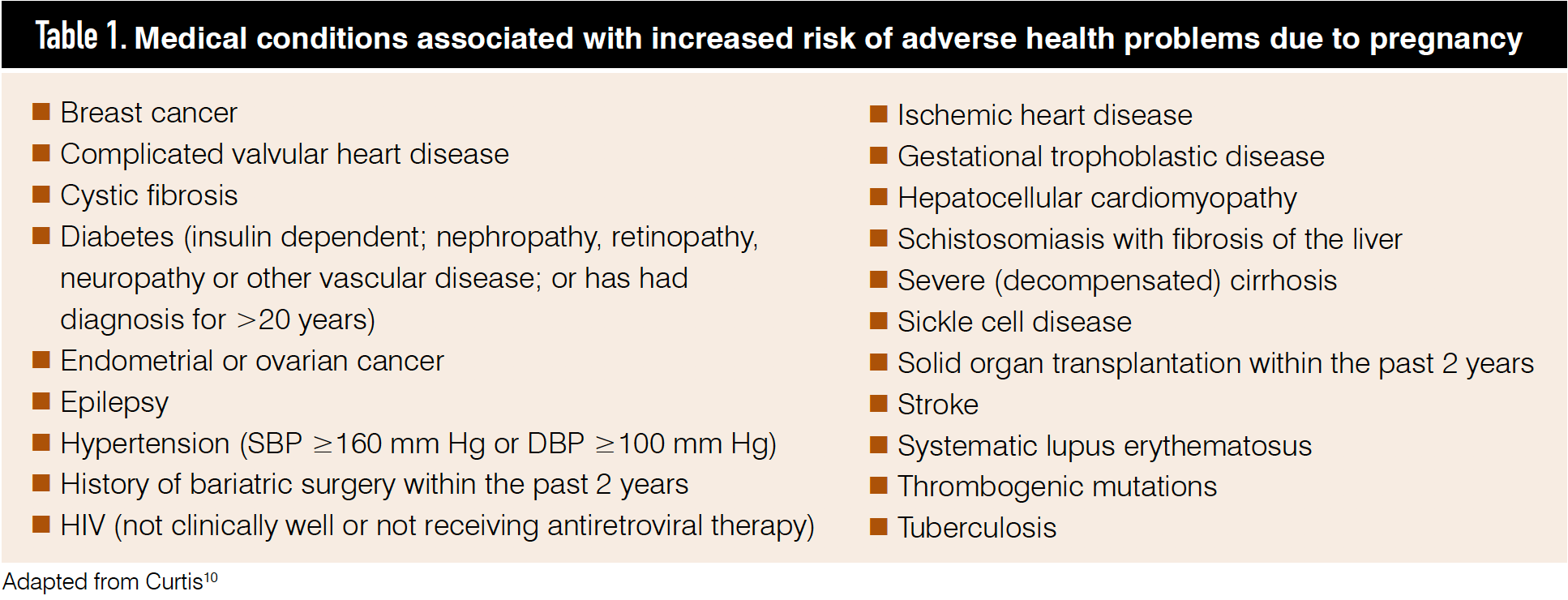
EE is pro-coagulable and is contraindicated in a number of situations. Progestin also has risks to the user. Providers should screen for personal or family history of venous thromboembolism, as this increases coagulation risk in COC users.
Additionally, because of hypercoagulability in the postpartum state, COCs should not be used until 6 weeks after childbirth. Women who smoke and are over age 35, women with migraine with aura, or those who have uncontrollable hypertension or vascular disease are at increased risk of stroke and should not use estrogen-containing methods.9
There are self-screening tools available to check for COC eligibility, such as the one used in a study by Grossman et al, which showed a sensitivity of 83.2% and specificity of 88.8% in patients using the survey to determine true contraindications to COC use.11 These tools can be helpful to both providers and patients, particularly as we increase use of telemedicine (Table 2).
Table 2. Screening tool for appropriate use of COCs
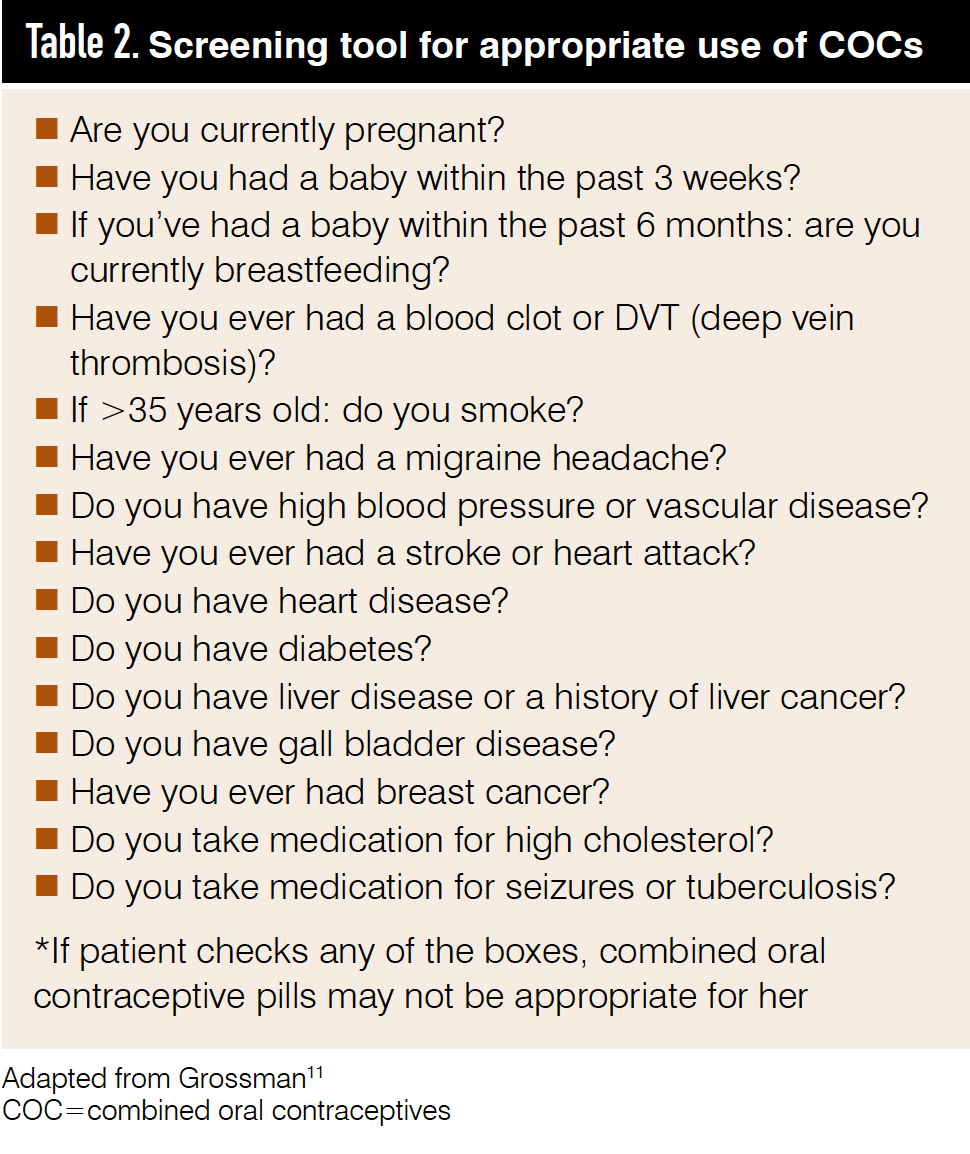
Shared decision-making
As with any medical decision, it is exceptionally important to utilize shared decision-making in choosing the right contraceptive method for each patient, which should improve satisfaction, encourage compliance, and reduce unintended pregnancy.
Shared decision-making involves the patient and provider working together to make a decision through discussion of all options while taking patient preference into account.12
Because there are many contraceptive options available, it is important to discuss values (including the acceptability of an unplanned pregnancy if there is a contraceptive failure), beliefs, dosing frequency, financial considerations, and risks and benefits of each method.
Other considerations include how often women want to have withdrawal bleeding, and desired benefits such as improvement in dysmenorrhea, acne, and mood symptoms. All women should be provided with a multiple-month prescription to improve medication adherence.
As with any method, there are side effects of COCs and POPs that are important to discuss with patients as they decide which method is best for them. Of women who have ever discontinued using COCs or POPs, 34% reported that they were dissatisfied and 64.4% stopped due to side effects.1
Some common side effects to discuss with women are breast tenderness, nausea, bloating, and breakthrough bleeding—all of which often improve or completely resolve after the first several months.13 Women may not always discuss their choice to stop taking COCs or POPs, making it essential for clinicians to ask about the experience of past side effects, as well as to provide preventive guidance about the possibility of side effects before starting a new method.
How to choose the right pill
Once a woman and her provider have decided on using COCs, there are multiple options. Patients desiring a withdrawal bleed may prefer a pill pack with monthly placebo pills, while patients desiring fewer menses prefer continuous use without placebo pills and may opt for extended cycle use.
Additionally, providers may identify other co-existing conditions that may be treated with COCs such as acne, undesired facial hair growth, bloating, and/or headaches. COCs can also help reduce risk of ovarian cysts, fibroids, and benign breast disease.14
As mentioned earlier, all COCs have a progestin and EE component and doses differ by pill type. COCs have a range of EE between 10-35 mcg.
A systematic review showed higher discontinuation rates for COCs with lower doses of EE, due to side effects such as breakthrough bleeding. To reduce estrogenic risks, it is reasonable to start at 20 mcg EE and increase if necessary,15 although for adolescents, data supports using a dose of 30 mcg EE or greater as lower doses of EE have been associated with impaired bone acquisition.16,17
Providers should consider the progestin component of the COC, or which progestin to use on its own in a POP, as this may result in undesired side effects.2,18-20
Some progestins are noted to have androgen-like effects, with users reporting oily skin, facial hair growth, or acne. Of note, all COCs have been shown to help with acne, but it is reasonable to choose a pill with a less androgen-like progestin and/or higher estrogen content if this is a concern.19,21,22
First-generation progestins have a lower potency and half-life, which can result in breakthrough bleeding. While second-generation progestins are more potent with a longer half-life, they may have an androgen-like effect. Third-generation progestins maintain a high potency but have lower androgen-like effects.
Some third-generation formulations are even approved to treat mild to moderate acne. Finally, the only fourth-generation progestin, drospirenone, has both anti-mineralocorticoid and anti-androgenic properties and is newly available in a progestin-only pill.18,19 It has an improved bleeding profile while matching COCs in efficacy, as well as extending the missed-pill window to 12 hours for ease of use23 (Table 3).
Table 3. Benefits of the new drosprienone-only POP
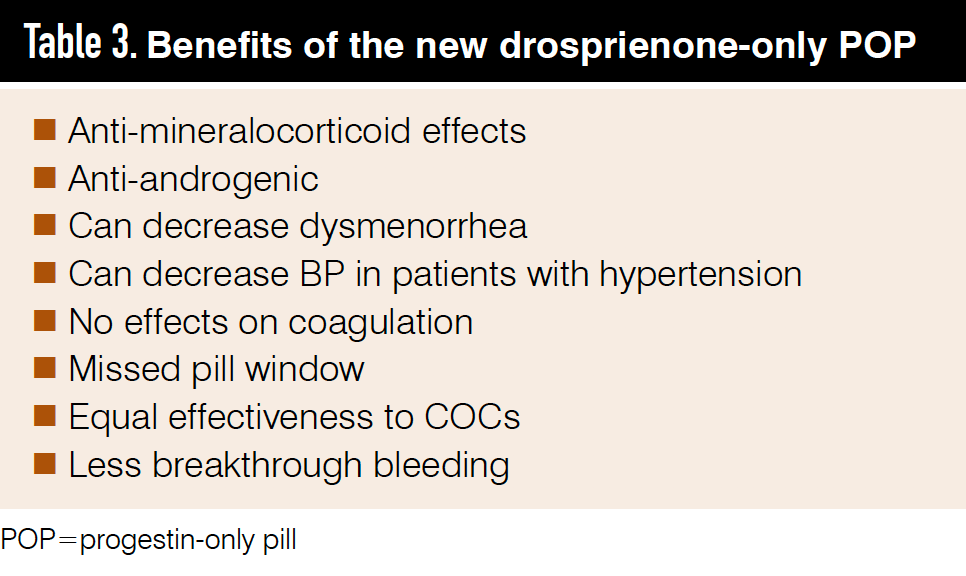
Many of the common side effects of COCs will resolve on their own in the first few months. Thus, in the absence of severe side effects, patients should be encouraged to continue their pills for an initial 3-month interval. If these side effects continue or are particularly bothersome, Table 4 shows some options providers can use to approach them.19,24
Table 4. Common side effects and how to approach them
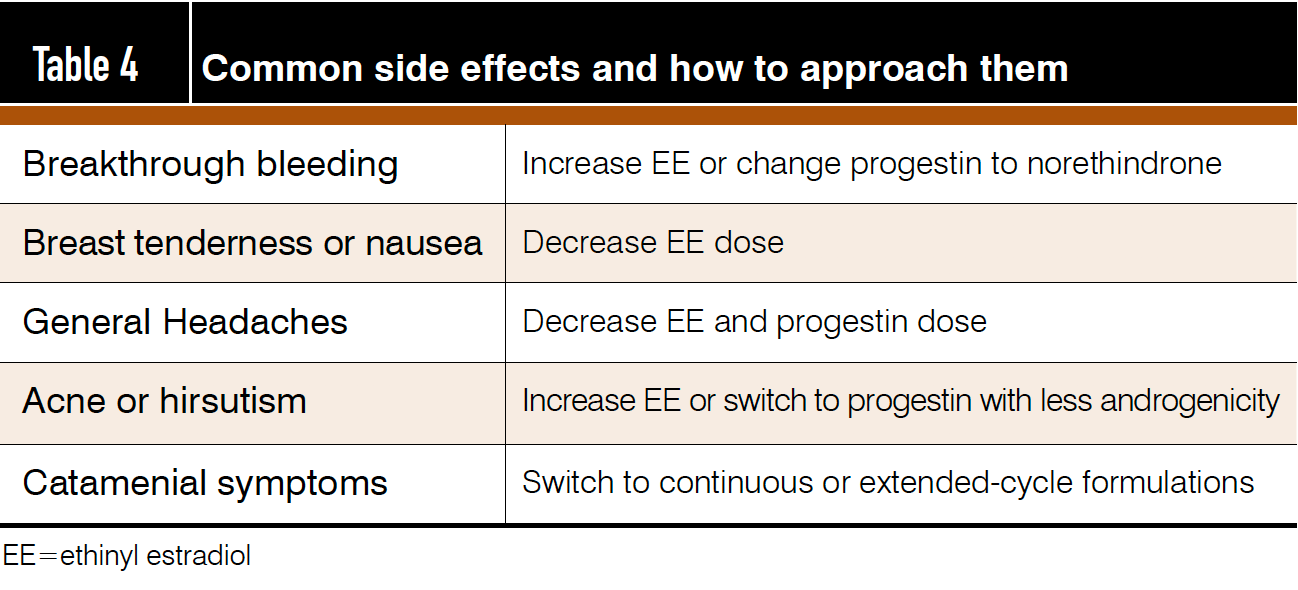
In addition to bleeding patterns and progestin options, COCs can be monophasic or multiphasic. We recommend that most providers start with a monophasic preparation for ease of use and ability to extend to continuous use, although some data show that triphasic preparations—specifically those with newer progestins—help reduce acne, irregular bleeding, and menorrhagia.25
Non-contraceptive benefits: dysmenorrhea and menorrhagia
In addition to contraception, COCs have non-contraceptive benefits that can be advantageous to patients. One of these benefits is helping to improve menstruation, reduce pain, and improve blood loss. Dysmenorrhea is the most common menstrual symptom complaint, affecting up to 90% of women.26
COCs have been shown to reduce dysmenorrhea by 60%, and in those with severe dysmenorrhea even further (90%). This reduces absences for school or work, as well as a patient’s need for pain medication. In women who suffer from dysmenorrhea, it can be especially helpful to be on extended or continuous COC preparations to further decrease pain.19 The desogestrel-only POP has also been shown to help improve dysmenorrhea.27
Menorrhagia is less common, yet still problematic, for patients, as it can lead to iron-deficiency anemia. COCs are particularly helpful for normalizing bleeding patterns and decreasing both amount and duration of bleeding.
However, other forms of contraception, such as hormonal intrauterine devices, can have similar effects—enhancing the need for shared decision-making with a patient when deciding which hormonal method is right for her.28
Additional benefits to COCs include the ability to allow a woman to predict her bleeding episodes and skip them if desired. While older generations of POPs often caused abnormal bleeding patterns in patients, new drospirenone-only pills have a more favorable bleeding profile.23
Non-contraceptive benefits: PMS and PMDD
COCs can also improve premenstrual syndrome (PMS) and premenstrual dysphoric disorder (PMDD). A study looking at both POPs and COCs and their effect on premenstrual mood found that use of either one of these pills did not affect mood in over 71% of women. The remaining women were split as to whether their mood was improved or worsened.
Having a history of premenstrual mood changes prior to starting a POP or COC was a strong predictor of the ability to improve mood, as was onset of premenstrual mood disturbance at a younger age. However, those with a history of depression prior to pill use were twice as likely than those without a history to have mood deterioration.29
Studies have also shown that in women being treated for depression, COCs containing drospirenone can improve mood deterioration in the premenstrual period, as well as reduce both physical and behavioral symptoms of PMDD.30 Another way to reduce PMS and PMDD symptoms is with extended or continuous cycles and reduction of withdrawal bleeding.19
Non-contraceptive benefits: Endometriosis
COCs can also be very useful to women who suffer from endometriosis. COCs have been shown to reduce pain associated with endometriosis and continuous cycles are often even more beneficial for pain reduction.
However, it is important to remember that COCs work by causing endometriotic implants to undergo atrophy and become inactive. Upon discontinuation of COCs, the implants become active again, resulting in return of pain and other symptoms.
Initiation of COCs after surgery for endometriosis can reduce recurrence rates of endometriomas, as well as the size and growth rates of those that do recur.31 For women who cannot take COCs but suffer from endometriosis, desogestrel-containing POPs have been shown to be equally effective in reducing endometriosis pain.14
Conclusion
Oral contraceptive pills are a widely used form of contraception and nearly all providers in all specialties will encounter patients who are taking them.
While different variations between pills can seem complicated, thereby making it hard to choose a pill, it is important to tailor the decision to each patient’s needs and desires. Sometimes it can take several adjustments to find the best OCP for a particular patient.
As long as the provider and patient continue to work together through shared decision-making, many women will be able to satisfactorily find a reliable form of contraception while also taking advantage of the many non-contraceptive benefits that pills offer.
__
About the Authors

DR. LODER is a clinical assistant professor at Michigan Medicine, University of Michigan, Ann Arbor.

DR. ROSEN is a clinical assistant professor at Michigan Medicine, University of Michigan, Ann Arbor.

DR. CHASE is a fourth-year medical student at the University of Michigan Medical School, Ann Arbor.
__
References
1. National Center for Health Statistics. National Survey of Family Growth 2015-2017. https://www.cdc.gov/nchs/nsfg/nsfg_2015_2017_puf.htm. Accessed May 10, 2020.
2. David PS, Boatwright EA, Tozer BS, et al. Hormonal contraception update. Mayo Clin Proc. 2006;81(7):949-954.
3. Trussell J. Contraceptive failure in the United States. Contraception. 2011;83(5):397-404.
4. Broome M, Fotherby K. Clinical experience with the progestogen-only pill. Contraception. 1990; 42(5):489-95.
5. Sheth A, Jain U, Sharma S, et al. A randomized, double-blind study of two combined and two progestogen-only oral contraceptives. Contraception. 1982;25(3):243-252.
6. Korver T. A double-blind study comparing the contraceptive efficacy, acceptability and safety of two progestogen-only pills containing desogestrel 75 μg/day or levonorgestrel 30 μg/day. Eur J Contracept Reprod Health Care. 1998;3(4):169-178.
7. Vessey MP, Lawless M, Yeates D, McPherson K. Progestogen-only oral contraception. Findings in a large prospective study with special reference to effectiveness. Br J Fam Plann. 1985;10:117-121.
8. Rivera R, Yacobson I, Grimes D. The mechanism of action of hormonal contraceptives and intrauterine contraceptive devices. Am J Obstet Gynecol. 1999;181(5 Pt 1):1263-1269.
9. Centers for Disease Control and Prevention. Summary Chart of U.S. Medical Eligibility Criteria for Contraceptive Use. https://www.cdc.gov/reproductivehealth/contraception/pdf/summary-chart-us-medical-eligibility-criteria_508tagged.pdf. Accessed May 10, 2020.
10. Curtis KM, Tepper NK, Jatlaoui TC, et al. U.S. Medical Eligibility for Contraceptive Use, 2016. MMWR Recomm Rep. 2016;65(3):1-103.
11. Grossman D, Fernandez L, Hopkins K, Amastae J, Garcia SG, Potter JE. Accuracy of self-screening for contraindications to combined oral contraceptive use. Obst Gynecol. 2008;112(3):572-578.
12. Elwyn G, Frosch D, Thomson R, et al. Shared decision making: A model for clinical practice. J Gen Intern Med. 2012;27(10):1361-1367.
13. Rosenberg MJ, Waugh MS, Meehan TE. Use and misuse of oral contraceptives: Risk indicators for poor pill taking and discontinuation. Contraception. 1995;51(5):283-288.
14. Amat L, Bulach A, Leclercq M, et al. Bénéfices non contraceptifs des contraceptions. Additional Non-Contraceptive Effects of Contraception: CNGOF Contraception Guidelines. Gynecol Obstet Fertil Senol. 2018;46(12):883-888.
15. Gallo MF, Nanda K, Grimes DA, Lopez LM, Schulz KF. 20 µg versus >20 µg estrogen combined oral contraceptives for contraception. Cochrane Database Syst Rev. 2013;2013(8):CD003989.
16. Golden NH. Bones and Birth Control in Adolescent Girls. J Pediatr Adolesc Gynecol. 2020;33(3):249-254.
17. Scholes D, Ichikawa L, LaCroix AZ, et al. Oral contraceptive use and bone density in adolescent and young adult women. Contraception. 2020;81(1):35-40.
18. Lawrie TA, Helmerhorst FM, Maitra NK, Kulier R, Bloemenkamp K, Gülmezoglu AM. Types of progestogens in combined oral contraception: effectiveness and side-effects. Cochrane Database Syst Rev. 2011;11(5):CD004861.19. Raney EC, Scott SC, Cauthon KAB. Individualizing selection of hormonal contraception. Osteopathic Family Physician. 2014;6(4):8-14.
20. Sitruk-Ware R. Pharmacology of different progestogens: The special case of drospirenone. In Climacteric. 2005;8(Suppl 3):4-12.
21. Thorneycroft IH. Update on androgenicity. Am J Obstet Gynecol. 1999;180(2 Pt 2):288-294.
22. Stanczyk FZ. All progestins are not created equal. Steroids. 2003;68(10-13):879-890.
23. Palacios S, Regidor PA, Colli E, et al. Oestrogen-free oral contraception with a 4 micrograms drospirenone-only pill: new data and a review of the literature. Eur J Contracept Reprod Health Care. 2020;Apr 21;1-7. https://doi.org/10.1080/13625187.2020.1743828. Online ahead of print.
24. Barr NG. Managing adverse effects of hormonal contraceptives. Am Fam Physician. 2010;82(12):1499-1506.
25. Cedars MI. Triphasic oral contraceptives: Review and comparison of various regimens. Fertil Steril. 2002;77(1):1-14.
26. Jamieson DJ, Steege JF. The prevalence of dysmenorrhea, dyspareunia, pelvic pain, and irritable bowel syndrome in primary care practices. Obstet Gynecol. 1996;87(1):55-58.
27. Ahrendt HJ, Karckt U, Pichl T, Mueller T, Ernst U. The effects of an oestrogen-free, desogestrel-containing oral contraceptive in women with cyclical symptoms: Results from two studies on oestrogen-related symptoms and dysmenorrhoea. Eur JContracept Reprod Health Care. 2007;12(4):354-361.
28. Lethaby A, Wise MR, Weterings MAJ, Rodriguez MB, Brown J. Combined hormonal contraceptives for heavy menstrual bleeding. In Cochrane Database System Rev. 2019;2(2):CD000154.
29. Joffe H, Cohen LS, Harlow BL. Impact of oral contraceptive pill use on premenstrual mood: Predictors of improvement and deterioration. Am J Obstet Gynecol. 2003; 189(6):1523-1530.
30. Yonkers KA, Brown C, Pearlstein TB, Foegh M, Sampson-Landers C, Rapkin A. Efficacy of a new low-dose oral contraceptive with drospirenone in premenstrual dysphoric disorder. Obstet Gynecol. 2005;106(3):492-501.
31. Zorbas KA, Economopoulos KP, Vlahos NF. Continuous versus cyclic oral contraceptives for the treatment of endometriosis: a systematic review. In Arch Gynecol Obstet. 2015;292(1):37-43.
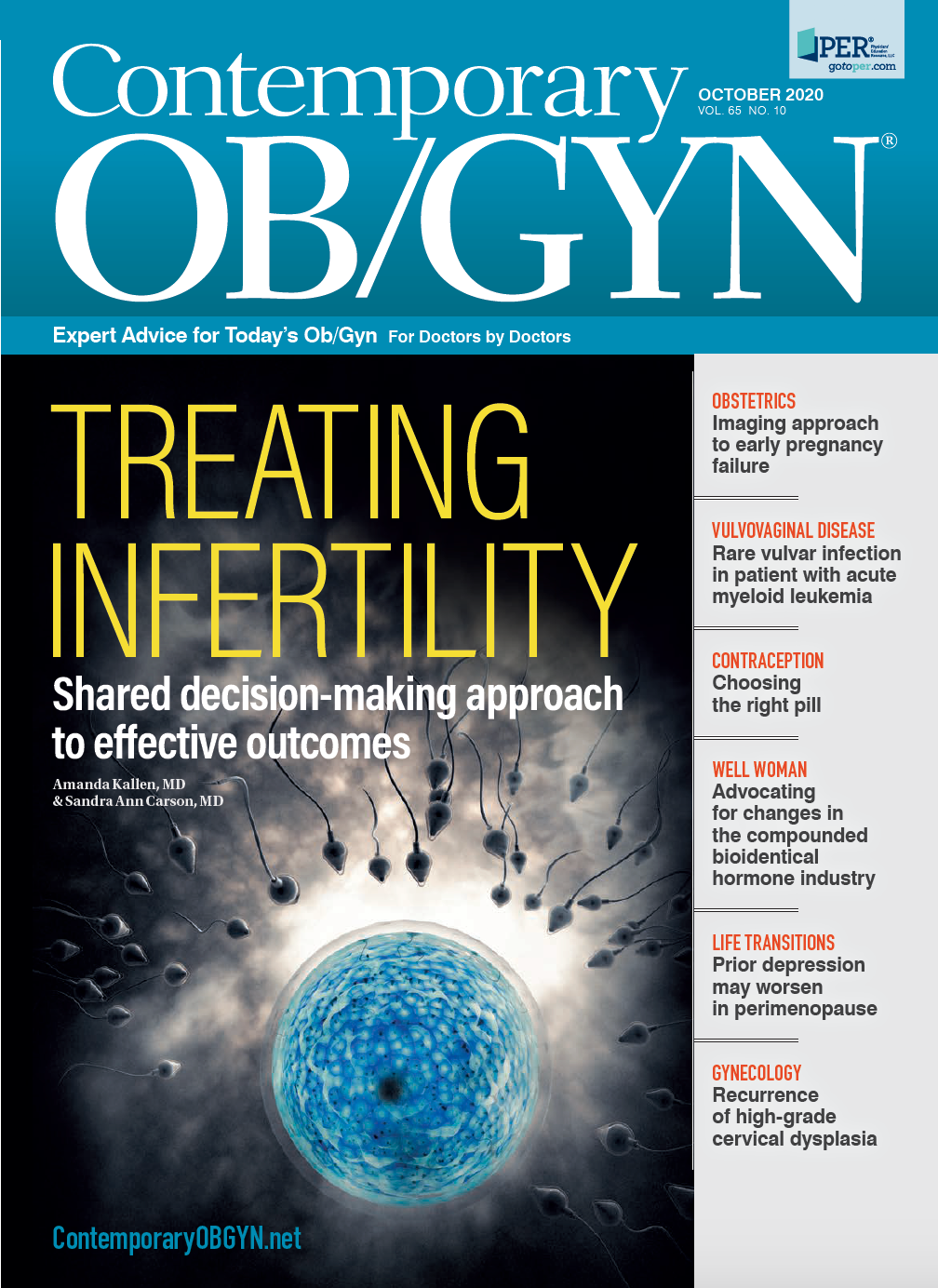
Recap on reproductive rights with David Hackney, MD, MS
December 20th 2022In this episode of Pap Talk, we spoke with David Hackney, MD, MS, maternal-fetal medicine physician at Case Western Reserve University and chair of ACOG's Ohio chapter for a full recap of where restrictions on reproductive rights have been and where they're going.
Listen
In this episode of Pap Talk, Gloria Bachmann, MD, MSc, breaks down what it means to be a health care provider for incarcerated individuals, and explores the specific challenges women and their providers face during and after incarceration. Joined by sexual health expert Michael Krychman, MD, Bachmann also discusses trauma-informed care and how providers can get informed.
Listen
